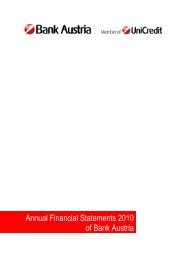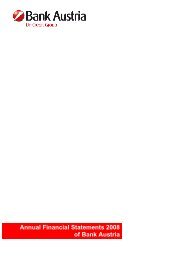Annual Financial Statements 2011 of Bank Austria
Annual Financial Statements 2011 of Bank Austria
Annual Financial Statements 2011 of Bank Austria
Create successful ePaper yourself
Turn your PDF publications into a flip-book with our unique Google optimized e-Paper software.
Management Report <strong>of</strong> UniCredit <strong>Bank</strong> <strong>Austria</strong> AG<br />
collateral management and margining. There are also stricter<br />
requirements in respect <strong>of</strong> stress testing and backtesting. The<br />
approval process for the adapted model is planned to start in the<br />
middle <strong>of</strong> 2012.<br />
Liquidity<br />
Basel 3 sets liquidity standards under stressed conditions in the<br />
short-term maturity range (liquidity coverage ratio = 100%) and in<br />
the structural sector (net stable funding ratio = 1). Although<br />
compliance with these rules will not be mandatory before 2015,<br />
<strong>Bank</strong> <strong>Austria</strong> made the necessary extensions to the liquidity<br />
monitoring system in the course <strong>of</strong> <strong>2011</strong> and integrated the new<br />
regulatory standards in the current management information<br />
process.<br />
2.3. Third-party guarantees<br />
Under Section 92 (9) <strong>of</strong> the <strong>Austria</strong>n <strong>Bank</strong>ing Act, "Privatstiftung<br />
zur Verwaltung von Anteilsrechten" ("AVZ Stiftung", a private<br />
foundation under <strong>Austria</strong>n law) serves as deficiency guarantor for<br />
all liabilities <strong>of</strong> UniCredit <strong>Bank</strong> <strong>Austria</strong> AG in the event <strong>of</strong> the<br />
company's insolvency.<br />
After the change in the legal form <strong>of</strong> Anteilsverwaltung-<br />
Zentralsparkasse into a private foundation (“AVZ Stiftung”) in 2001,<br />
the Municipality <strong>of</strong> Vienna serves as deficiency guarantor for all<br />
outstanding liabilities, and obligations to pay future benefits, <strong>of</strong><br />
UniCredit <strong>Bank</strong> <strong>Austria</strong> AG (then <strong>Bank</strong> <strong>Austria</strong> Aktiengesellschaft)<br />
which were entered into prior to and including 31 December 2001.<br />
2.4. Outlook for 2012<br />
The economic environment<br />
The moderate upturn <strong>of</strong> the global economy, underway since<br />
2010, has lost momentum since autumn <strong>2011</strong>. According to the<br />
most recent sentiment indicators and leading indicators, the<br />
lacklustre performance is likely to be only temporary. But the worse<br />
than expected economic developments in the second half <strong>of</strong> <strong>2011</strong>,<br />
and probably also in the first quarter <strong>of</strong> 2012, have reduced the<br />
prospects for the economy to get <strong>of</strong>f to a reasonable start in 2012.<br />
<strong>Annual</strong> growth rates for 2012 have consequently been revised<br />
downwards. Global trade slowed towards the end <strong>of</strong> <strong>2011</strong>, but still<br />
recorded growth in a year-on-year comparison; we expect global<br />
trade to pick up again as from spring 2012. We think that from<br />
3.3% in 2012, global economic growth will return to a level <strong>of</strong> 4% in<br />
2013.<br />
With an anticipated growth rate <strong>of</strong> between 9% and 10% in 2012,<br />
China will provide the main impetus for global economic growth.<br />
The performance <strong>of</strong> the US economy in 2012 will fall somewhat<br />
short <strong>of</strong> its potential growth (2 % after 1.7 %). In the euro area, the<br />
economy contracted by 0.3 % in the fourth quarter <strong>of</strong> <strong>2011</strong><br />
compared with Q3 <strong>2011</strong>, and will remain weak in the first quarter <strong>of</strong><br />
2012. In addition to a technical recession (two quarters <strong>of</strong><br />
seasonally-adjusted negative growth) the less favourable starting<br />
position (negative carry-over effect) will lower the growth rate<br />
expected for 2012 to 0% to ½%. All forecasts are made on the<br />
premise that confidence in the debt-bearing capacity <strong>of</strong> industrial<br />
countries will slowly be restored, that it will at least not be shaken<br />
again, and that a renewed sharp rise in commodity prices<br />
(triggered, for example, by a culmination <strong>of</strong> events at the Persian<br />
Gulf) can be prevented.<br />
Since the beginning <strong>of</strong> the current year, favourable leading<br />
indicators and sentiment surveys in <strong>Austria</strong> have suggested that<br />
the intermediate low may be coming to an end. The <strong>Austria</strong>n<br />
economy will return to a growth path in the first half <strong>of</strong> 2012, though<br />
expansion will be very moderate. Weak foreign demand, consumer<br />
restraint and a cautious approach to business investment will limit<br />
economic growth for the time being. From the middle <strong>of</strong> the year,<br />
impetus provided by the Asian emerging economies should have<br />
an indirect effect on <strong>Austria</strong>n industry via Germany, <strong>Austria</strong>’s main<br />
trading partner, and this should reinvigorate the economy.<br />
Investment projects which were postponed should then be carried<br />
out and consumption should pick up, supported by weakening<br />
inflation (expected to average 2.2 % in 2012) and a slightly positive<br />
trend in real incomes. Despite the economic revival in the course <strong>of</strong><br />
the year, growth will be moderate, reaching only 0.8 % for 2012 as<br />
a whole. This also reflects the low base before and after the turn <strong>of</strong><br />
the year. The unemployment rate will rise slightly in 2012, to 4.3<br />
per cent, though remaining very low by international comparison.<br />
GDP is expected to grow by 2 % in 2013, when budget<br />
consolidation measures will become fully effective, but dampening<br />
growth only slightly. According to preliminary calculations, the<br />
direct dampening effect for 2013 will be about ¼ percentage point<br />
<strong>of</strong> GDP and will be more than <strong>of</strong>fset by stronger global economic<br />
trends. In view <strong>of</strong> the moderate economic outlook, credit expansion<br />
is expected to show hardly any change in the course <strong>of</strong> 2012, with<br />
growth again reaching between 2% and 3%. The major challenges<br />
facing the banks (buildup <strong>of</strong> additional risk buffers, difficult funding<br />
conditions, management <strong>of</strong> liquidity ratios) led to high and rising<br />
interest rates on bank deposits in the second half <strong>of</strong> <strong>2011</strong>, which<br />
rose by over 3%. Deposits from private customers increased by<br />
close to 2 % and accounted for about one-half <strong>of</strong> additions to<br />
financial assets held by private households. In 2012, monetary<br />
capital formation could be somewhat more pronounced. At the<br />
current low valuation levels in some areas, capital markets <strong>of</strong>fer<br />
attractive investment opportunities. But deposit interest rates will<br />
probably remain attractive also in 2012.<br />
Countries in Central and Eastern Europe (CEE) were also<br />
affected by the deterioration in the global economic environment in<br />
the second half <strong>of</strong> <strong>2011</strong> and around the turn <strong>of</strong> the year. Overall,<br />
however, the region continued to pursue sound expansion. As the<br />
European debt crisis escalated, risk aversion again became more<br />
pronounced. But given the relatively low levels <strong>of</strong> government debt<br />
in the region, CEE coped well with this situation. Developments in<br />
the euro area will continue to be among the factors determining<br />
trends in the CEE region later in 2012. The difference between a<br />
weak first six months and more lively business in the second halfyear<br />
will be particularly apparent in the Central European countries,<br />
which are closely integrated in the production network. The impact<br />
on major exporters <strong>of</strong> raw materials and commodities will be<br />
weaker, these countries will benefit from high oil prices. Turkey,<br />
which enjoys a high degree <strong>of</strong> economic autonomy, continues to<br />
achieve strong growth even if the boom <strong>of</strong> past years is over.<br />
Overall, we expect that economic growth in CEE (in <strong>Bank</strong> <strong>Austria</strong>’s<br />
perimeter) will be 3.0 % (2012) and 3.8 % (2013), double or triple<br />
the figure for Western Europe. Despite significant regional<br />
divergence, we expect that the CEE region as a whole will see<br />
currency appreciation rather than depreciation. This will require<br />
stable inflows <strong>of</strong> long-term capital.<br />
<strong>Bank</strong> <strong>Austria</strong> – <strong>Annual</strong> <strong>Financial</strong> <strong>Statements</strong> <strong>2011</strong> 205
















